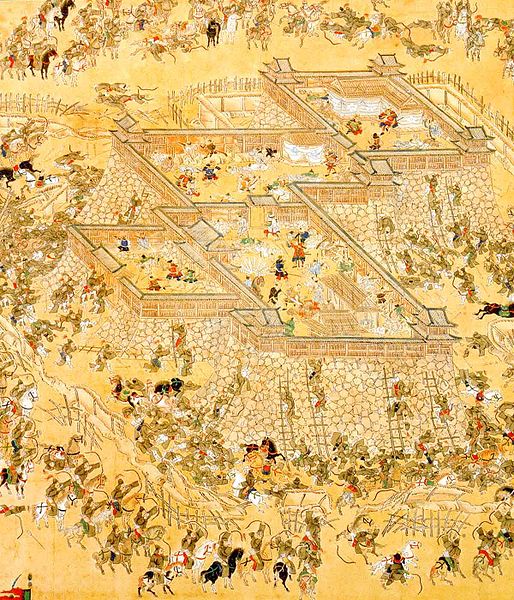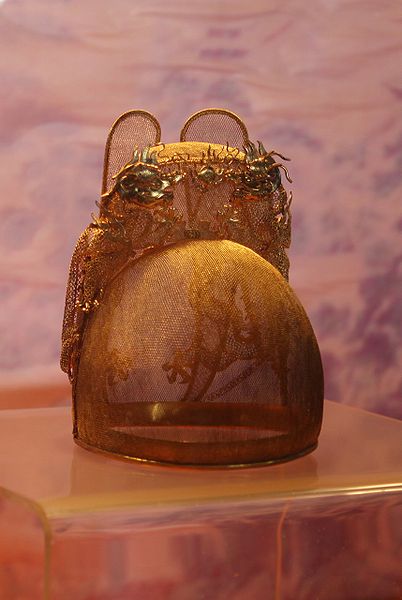<Back to Index>
- Inventor Martin Wiberg, 1826
- Architect Daniel Hudson Burnham, 1846
- Emperor of China Wanli, 1563
PAGE SPONSOR
The Wanli Emperor (4 September 1563 – 18 August 1620) was emperor of China (Ming dynasty) between 1572 and 1620. His era name means "Ten thousand calendars". Born Zhu Yijun, he was the Longqing Emperor's son. His rule of forty eight years was the longest in the Ming dynasty and it witnessed the steady decline of the dynasty. Wanli also saw the arrival of the first Jesuit missionary in Beijing, Matteo Ricci.
Wanli ascended the throne at the age of 9. For the first ten years of his reign, the young emperor was aided by a notable statesman, Zhang Juzheng. Zhang Juzheng directed the path of the country and exercised his skills and power as an able administrator. At the same time, Wanli deeply respected Zhang as a mentor and a valued minister. However as Wanli's reign progressed, different factions within the government began to openly oppose Zhang's policy as well as his powerful position in government and courted Wanli to dismiss Zhang. By 1582, Wanli was a young man of 19 and was tired of the strict routine Zhang still imposed on the emperor since childhood. As such, Wanli was willing to consider dismissing Zhang but before Wanli was able to act, Zhang died in 1582. Overall during these 10 years, the Ming Dynasty's economy and military power prospered in a way not seen since the Yongle Emperor and the "Ren Xuan Rule" from 1402 to 1435. After Zhang's death, Wanli felt that he was free of supervision and reversed many of Zhang's administrative improvements. In 1584, Wanli issued an edict and confiscated all of Zhang's personal wealth and his family members were purged.
After Zhang Juzheng died, Wanli decided to take complete control of the government. During this early part of his rule he demonstrated himself a decent and diligent emperor. Overall, the economy continued to prosper and the country remained powerful. Unlike the 20 years at the end of his rule, Wanli at this time would attend every morning meetings and discuss affairs of state. The first eighteen years of Wanli's reign would be dominated by three wars that he dealt with successfully:
- Defense against the Mongols. In the outer regions, one of the leaders rebelled and allied with the Mongols to attack the Ming. At this time, Wanli sent out Li Chengliang and sons to handle the situation, resulting in overall success.
- Toyotomi Hideyoshi of Japan sent 200,000 soldiers in the first expedition to invade Korea. Wanli made three decisions. First, he sent a 3,000 man army to reinforce the Koreans. Second, if Koreans entered Ming territory, he gave them lodging. Third, he instructed the Liaodong area to prepare and be vigilant. In actual combat, the first 2 battles were defeats since Ming troops under Li Rusong were outnumbered and ill-prepared to fight the 200,000-strong Japanese army. Wanli then sent a bigger army of 80,000 men, with more success. This resulted in negotiations that favored the Ming. Two years later, in 1596, Japan once again invaded. However, that same year, Hideyoshi died and the Japanese lost their will to fight. Combined with the leadership of the Korean admiral Yi Sun-sin and the bogging down of Japanese forces in the Korean mainland, the Ming Dynasty defeated the demoralized Japanese army.
- The Yang Yinlong rebellion. At first, Wanli was engaged in war with Japan and sent only 3,000 troops under the command of Yang Guozhu to fight the rebellion. Unfortunately, this army was completely annihilated and Yang Guozhu was killed. When war with Japan ended, Wanli turned his attention to Yang Yinlong, sending Guo Zhizhang and Li Huolong to lead the offensive. In the end, Li Huolong defeated Yang's army and brought him back to the capital.
After
these three successful conflicts, Wanli stopped going to morning
meetings, going into his later reign and his final 20 years on the
throne. During
the latter years of Wanli's reign, he seldom attended state affairs and
for years at a time would refuse to receive his ministers or read any
reports sent to him. Wanli also extorted money from the government, and
ultimately his own people, for his personal enjoyment. One example was
the close attention he paid to the construction of his own tomb, which
took decades to complete. The
Wanli Emperor then became disenchanted with the moralistic attacks and
counterattacks of officials, becoming thoroughly alienated from his
imperial role. Throughout the 1580s and 1590s, Wanli yearned to promote
his third son (Zhu Changxun) by Lady Zheng as crown prince; however, many
of his powerful ministers were opposed to the idea. This led to a clash
between sovereign and ministers that lasted more than 15 years. In
October of 1601 Emperor Wanli eventually gave in and promoted Zhu
Changluo — later Emperor Taichang — as crown prince. Although the
ministers seemed to have overpowered the emperor, Wanli finally
resorted to vengeful tactics of blocking or ignoring the conduct of
administration. For years on end he refused to see his ministers or act
upon memoranda. He refused to make necessary appointments, and
eventually became so obese he was unable even to stand without
assistance. The
whole top echelon of Ming administration became understaffed. In short,
Wanli tried to forget about his imperial responsibilities while
building up personal wealth. Considering the emperor's required role as
the linchpin of the state, this personal rebellion against the
bureaucracy was not only bankruptcy but treason. Finally,
the future threat of the Manchurians developed. The Jurchen area was
eventually conquered by Nurhaci. Nurhaci would go on to create the
Later Jin Empire which would now become an immediate threat. By this
time, after 20 years, the Ming Dynasty army was in steep decline. While
the Jurchens were fewer in number, they were more fierce and powerful. In
the grand battle of Nun Er Chu in 1619, the Ming Dynasty sent out a
force of 200,000 against the Later Jin Empire of 60,000, with Nurhaci
controlling 6 banners and 45,000 as the central attack while Dai Shan
and Huang Taji each controlled 7,500 troops and one banner attacked
from the sides. After 5 days of battle, the Ming Dynasty had casualties
over 100,000, with 70% of their food supply stolen. From this point on,
the Ming Dynasty would lose its advantage to the Jurchens, setting up
the eventual downfall of the Ming Dynasty to the Qing Dynasty.
In
1615 the court was hit by yet another scandal. A man by the name of
Zhang Chai armed with no more than a wooden staff managed to
chase off eunuchs guarding the gates and broke into Ci-Qing palace, then the Crown Prince’s living quarters. Zhang Chai was
eventually subdued and thrown in prison. Initial investigation found
him to be a lunatic, but upon further investigation by a more
conscientious magistrate named Wang Zhicai the man confessed
to being party to a plot instigated by two eunuchs working under Lady
Zheng. According to Zhang Chai’s confession, the two had promised him
rewards for assaulting the Crown Prince, thus implicating the Emperor’s
favorite concubine in an assassination plot. Presented with the
incriminating evidence and the gravity of the accusations, Emperor
Wanli, in an attempt to spare Lady Zheng, personally presided over the
case. He laid the full blame on the two implicated eunuchs who were
executed along with the would-be assassin. Although the case was
quickly hushed up, it did not squelch public discussion and eventually
became known as the "Case of the Palace Assault", one of
three notorious 'mysteries' of the Late Ming Dynasty.
Lady
Zheng (1567? - 1630) was Wanli's favourite concubine who gave birth to
Wanli's third son Zhu Changxun in 1586. Wanli was unable to promote
Lady Zheng as Empress during his reign as well as his son Zhu Changxun
as crown prince due to the opposition of his ministers. Wanli
eventually promoted Lady Zheng as Empress on his deathbed in 1620.
However, this order was never fulfilled by the officials before the
fall of Ming Dynasty. In 1644, since Hongguang Emperor, the first sovereign of the Southern Ming Dynasty,
was a grandson of Lady Zheng, the lady was finally promoted as Empress
by the Southern Ming government, 14 years after her death. The
Wanli emperor’s reign is representative of the decline of the Ming. He
was an unmotivated and avaricious ruler whose reign was plagued with
fiscal woes, military pressures, and angry bureaucrats. He also had
sent eunuch supervisors to provinces to oversee mining operations which
actually became covers for extortion. Discontented with the lack of
morals during this time, a group of scholars and political activists
loyal to Zhu Xi and against Wang Yangming, created the Donglin Movement, a political group who believed in upright morals and tried to influence the government. During
the closing years of Wanli's reign, the Manchu began to conduct raids
on the northern border of the Ming Empire. Their depredations
ultimately led to the overthrow of the Ming dynasty in 1644. It was
said that the fall of the Ming dynasty was not a result of the Chongzhen Emperor's rule but instead due to Wanli's gross mismanagement. The Wanli Emperor died in 1620 and was buried in Dingling located on the outskirts of Beijing.
His tomb is one of the biggest in the vicinity and one of only two that
are open to the public. In 1997 China's Ministry of Public Security
published a book on the history of drug abuse. It stated that the Wanli
emperor's remains had been examined in 1958 and found to contain
morphine residues at levels which indicate that he had been a heavy and
habitual user of opium. On
the other hand, Emperor Wanli's contribution to the defense of the
Chosun Dynasty in Korea against the Japanese invasion has endeared him
to Koreans over the centuries. In the late 1990s, Koreans still paid
respect to Wanli. In
many ways, he was similar to other Chinese emperors who were initially
successful, but whose subsequent poor rule caused the eventual demise
of their dynasties, such as Emperor Xuanzong of Tang and the Qianlong Emperor of the Qing Dynasty.

